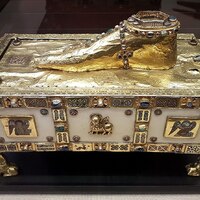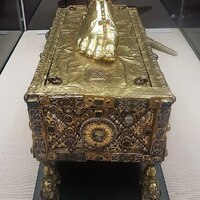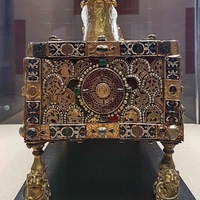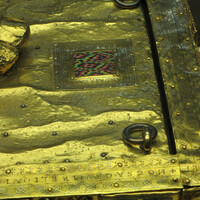Sandal altar-reliquary
Type:
Altars,
Reliquaries
Date:
980
Location or Findspot (Modern-Day Country):
Germany
Medium:
Enamel,
Gilt-silver,
Gold,
Pearl
Dimensions:
total H 33 × L 84 × W 45 cm
Description:
This portable altar-reliquary, made of silver, gold, gems, pearls and enamel, contains a piece of the sandal of St. Andrew, the brother of St. Peter and one of Jesus's earliest apostles. The work was commissioned by Egbert, archbishop of Trier (r. 977–93), around 980. By doing so, Egbert connected Trier with Constantinople, where Andrew, with Mary, was the patron saint. Another lavish reliquary made for Egbert at the same time enshrined the staff of St. Peter, thus forging a link with Rome, where Peter had been the first bishop. By patronizing reliquaries of Andrew and Peter, Egbert made claims about Trier's apostolic origins—its first bishop had supposedly been sent there by St. Peter—and elevated his bishopric over those of episcopal rivals in Cologne and Mainz. The use of spolia on the reliquary, particularly a Merovingian disk-shaped fibula with a coin of the sixth-century Emperor Justinian at its center (on the short heel side), also proclaims the venerable age of the box and its contents.
The Latin inscription on the top announces that the object is an "altar consecrated to Andrew" and that it contains not only the apostle's sandal but also the beard of St. Peter, links from Peter's prison chain (Acts 12:4–7), a nail from Jesus's Crucifixion (in its own container), and additional unspecified relics. The foot displayed on the lid thus "speaks" about only one of the contents, but it must have been an effective liturgical prop for the traveling archbishop. The gold lions that support the box have rings in their mouths, underscoring its portability and connecting it to the earliest traveling container for a biblical treasure: the Ark of the Covenant (note the rings and the carrying poles through them on the ninth-century monumental depiction of the Ark at Germigny-des-Prés). Christian commentators equated the rings used for carrying the Ark with the four Gospels, and the evangelists' symbols adorn the sides of the box.
Sandals and shoes were contact relics, not body parts, but they were understood to be intimately connected to their wearers because they molded to the feet. Only the gemmed straps are depicted on the altar-reliquary at Trier; the sandal has no sole. Sandal (n'al) imagery was also important in Islamicate lands, where the footwear was a miracle-working relic of Muhammad, who had touched the throne of God with his sandal. The Prophet's sandal was represented on Islamic pilgrimage certificates, and paper copies were considered efficacious souvenirs.
The Latin inscription on the top announces that the object is an "altar consecrated to Andrew" and that it contains not only the apostle's sandal but also the beard of St. Peter, links from Peter's prison chain (Acts 12:4–7), a nail from Jesus's Crucifixion (in its own container), and additional unspecified relics. The foot displayed on the lid thus "speaks" about only one of the contents, but it must have been an effective liturgical prop for the traveling archbishop. The gold lions that support the box have rings in their mouths, underscoring its portability and connecting it to the earliest traveling container for a biblical treasure: the Ark of the Covenant (note the rings and the carrying poles through them on the ninth-century monumental depiction of the Ark at Germigny-des-Prés). Christian commentators equated the rings used for carrying the Ark with the four Gospels, and the evangelists' symbols adorn the sides of the box.
Sandals and shoes were contact relics, not body parts, but they were understood to be intimately connected to their wearers because they molded to the feet. Only the gemmed straps are depicted on the altar-reliquary at Trier; the sandal has no sole. Sandal (n'al) imagery was also important in Islamicate lands, where the footwear was a miracle-working relic of Muhammad, who had touched the throne of God with his sandal. The Prophet's sandal was represented on Islamic pilgrimage certificates, and paper copies were considered efficacious souvenirs.
Relevant Textbook Chapter(s):
6
Image Credits:
Wikimedia Commons; Flickr, Brad Hostetler






